  |
The trip began
on an airplane. From Vancouver to Minneapolis, and Minneapolis
to Philadelphia, the seat beside me was empty. My banana got
to fly in comfort. |
 |
Soon, I was in
Philly marvelling at its architecture for the first time in my
life. |
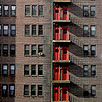 |
Philadelphia
June 11-15, 2003 |
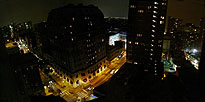 |
The view from my
hotel window, downtown, looking southeast. That's the corner
of Walnut and 13th St. below. |
 |
This little tree
germinated at the bottom of a sidewalk service well. This picture
doesn't show it, but the tree had grown six feet to reach this
grate and the sunlight beyond. For all but the last foot of that
distance, the tree was a slender, leafless, twig. |
  |
I was in town for
"Furniture 2003", the annual conference of The Furniture
Society, an association of studio furniture makers, like myself. |
 |
Whenever I was
walking, however, I was soaking up the architecture. Such as
this view of early 20th century construction. |
 |
Or (shot from the
same location, in the opposite direction) this view of mid-century
buildings (with post-modern public art). |
 |
Or (a few blocks
away) this view of end-of-century building. |
 |
More public art
- this time in tribute to Art Nouveau. |
  |
Philadelphians
are an approachable, talkative bunch like most Americans I've
met. But they have a confident gentility that, as you might imagine,
struck me as colonial. They jaywalk with a passion, and if honked
at, they honk back louder. |
 |
|
 |
Branding of all
kinds. |
 |
Yet another brand. |
  |
Table by Dan Jackson,
1959. The conference included a Jackson retrospective. It was
my first exposure to his work. He worked and taught in Philly
in the 60's and 70's. I love how relaxed and fluid his work is.
It inspires me to get out the rasps and get curvy. He studied
for a time in Denmark. |
  |
|
 |
|
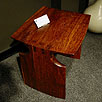 |
Renwick Stool.
David Ebner, 1975. |
 |
Hammer Handle Chair.
Wharton Esherick, 1940. Esherick is the grandaddy of American
Craft Furniture. This piece was part of an exhibition that included
other giants of the craft such as Sam Maloof and George Nakashima.
It was overwhelming to see their work in person. |
 |
This is the famous
"Slant Step." It was found in a junk shop and adopted
as a talisman of the 60's art scene. It would go missing, trade
hands, and mysteriously find it's way to key events and into
famous photos. It inspired an exhibition, a book, and numerous
prints, paintings and replicas. No doubt part of its appeal to
the conceptual crowd is the fact that, although it appears very
well used, its function is a mystery. |
| |
|
| |
continued
above |
| |
|
|
|
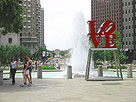 |
Standing
in J.F.K. Plaza looking down Ben Franklin Parkway, a turn-of-the-twentieth-century
urban renewal project that created a wonderful boulevard between
City Hall (next photo) and the Philadelphia Museum of Art (centre). |
 |
I moved
around the fountain pictured above to take this shot of William
Penn standing atop City Hall. (Trivia nuget: this is the largest
statue to adorm any building in the world.) |
 |
Logan
square, in the middle of the boulevard, en route to the Museum
of Art. It was a hot day. |
 |
The
museum. I was equipped with a map highlighting the furniture
collection, and was excited to visit the Marcel Duchamp installations
too. Sadly, I spent so much time with the collections of modern
art that the museum closed before I got to see their Shaker furniture. |
 |
|
 |
Lots
of famous chairs. L-R: Sitzmaschine 670. Josef Hoffmann.
1908. Two bentwood chairs by Michael Thonet. c. 1850. Wertheim
chair. Peter Behrens. 1902. And one of my favourite chairs,
Chair for a Music Room. Richard Riemerschmid. 1898. |
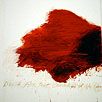 |
The
Fire that Consumes All Before It. Cy Twombly. 1977-78. Oil, oil
crayon, graphite on canvas. Part of a series of 10 or so huge
20 foot canvases retelling the Trojan War entitled Fifty Days
at Iliam. I cowered and nearly cried before the force of this
painting. |
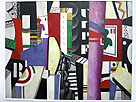 |
The
City. Fernand Léger. 1919. Oil on canvas. Compare left. |
 |
Architectural
study. Raymond Duchamp-Villon. 1914. Plaster. Although this detail
highlights an art nouveau motif, another section of the model
is cubist. Yes, Raymond was Marcel's brother. |
 |
Chair.
circa 1800. Engraved and stained ivory. Made in Vishakhapatnam
India for the British market. |
 |
Art
Nouveau chair. |
 |
The
Thinker. Auguste Rodin. 1880. Bronze. This was a 27" casting.
Rodin didn't give the thinker any genitals. |
 |
Torso
of a Young Man. Constantin Brancusi. 1917-22. Maple, limestone
block. |
 |
Satyr
and Nymph.I didn't note the artist. |
 |
Something
about this piece (the veneer? the flash? --ignore the cameo)
reminded me that contemporary studio furniture differs little
from guild furniture of the past. We like to think that we're
designerly, artistic and modern, but in reality our work chases
the same oppulent effect as this neo-classical table. We serve
the same market today as these makers did in their time. |
 |
I wandered around town a little
more before leaving. I avoided the Liberty Bell, but enjoyed
the Old City.
One evening as I sat reading
in Rittenhouse Square, a lovely 19th century park full of trees
and broad paths, a street person approached me for money to make
his way to a shelter that he said would turn his life around.
He didn't ask for money, however, until after he had earned it
by regaling me with many old-fashioned riddles - the kind that
used to keep us entertained before TV.
The only thing I didn't like
about Philly was the smell. Some noxious stench from the river
and the industry on it, creeps through the underground ways of
the city and escapes, from time to time, into the streets where
it wafts its dank, steamy way from ankle to nose.
|
 |
 |
 |
Bring
on the margaritas! |
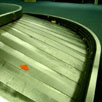 |
The
red tag reads, "fragile." It is now stuck to the conveyor. |
| |
© Jeff Hohner |
|












































